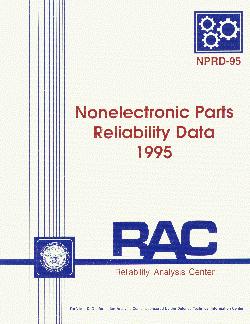Nonelectronic Parts Reliability Data
Reliability Analysis Center

Notes on:
Nonelectronic Parts Reliability DataReliability Analysis Center |
|
 |
Nonelectronic Parts Reliability Data, Reliability Analysis Center, Griffiss AFB, Rome NY, 1995 (1020 pages). Document F30602-91-C-0002.
I DON'T PUBLISH NOR SELL THIS BOOK -- CONTACT RAC FOR INFO ON OBTAINING IT!
This data source provides quantitative models based on real data of in-service component failure rates. The failure rates take into account the type of component, quality level of the component, and the application environment.
The data covers a large range of components and assemblies other than electronic componenents (which are covered in the companion EPRD-97 publication). A small sampling of the component types includes: accelerometers, air conditioners, batteries, ball bearings, brakes, seals, springs, switches, and hydraulic valves.
The data may be more applicable to military-grade components than commercial components. However, it is the most comprehensive data of this type available. As the military moves more to commercial off-the-shelf components, this data source will over time come into alignment with commercial design practices.
Topic coverage: (*** = emphasized; ** = discussed with some detail; * = mentioned)
| *** | Dependability | * | Electronic Hardware | Requirements | |||||
| Safety | Software | Design | |||||||
| Security | *** | Electro-Mechanical Hardware | Manufacturing | ||||||
| Scalability | Control Algorithms | Deployment | |||||||
| Latency | Humans | *** | Logistics | ||||||
| Affordability | Society/Institutions | Retirement |
Abstract:
This document provides failure rate data for a wide variety of component types including mechanical, electromechanical, and discrete electronic parts and assemblies. It provides both summary and detailed data sorted by part type, quality level, envirorunent and data source.
The data contained represents a compilation of field experience in military, commercial, and industrial applications, and concentrates on items not covered by MIL-HDBK-217, "Reliability Prediction of Electronic Equipment." Data tables include part descriptions, quality level, application environments, point estimates of failure rate, data sources number of failures, total operating hours, and detailed part characteristics. Indexes are also provided to assist in data retrieval.
SECTION 1: INTRODUCTION
1.1 Background 1-1
1.2 Data Collection 1-4
1.3 Data Interpretation 1-6
1.4 Document Overview 1-12
1.4.1 Section 2 "Part Summaries" Overview 1-12
1.4.2 Section 3 "Part Details" Overview 1-18
1.4.3 Section 4 "Data Sources" Overview 1-19
1.4.4 Section 5 "Part Number/MIL Number" Index 1-19
1.4.5 Section 6 "National Stock Number Index with
Federal Stock Class 1-19
1.4.6 Section 7 "National Stock Number Index
without Federal Stock Class Prefix 1-19
1.4.7 Section 8 "Part Description Index" Overview 1-20
SECTION 2: PART SUMMARIES 2-1
SECTION 3: PART DETAILS 3-1
SECTION 4: DATA SOURCES 4-1
SECTION 5: PART/MIL NUMBER INDEX 5-1
SECTION 6: NATIONAL STOCK NUMBER INDEX WITH
FEDERAL STOCK CLASS 6-1
SECTION 7: NATIONAL STOCK NUMBER INDEX WITHOUT
FEDERAL STOCK CLASS 7-1
SECTION 8: PART DESCRIPTION INDEX 8-1
Go to: other data sources | resource page
Philip Koopman: koopman@cmu.edu